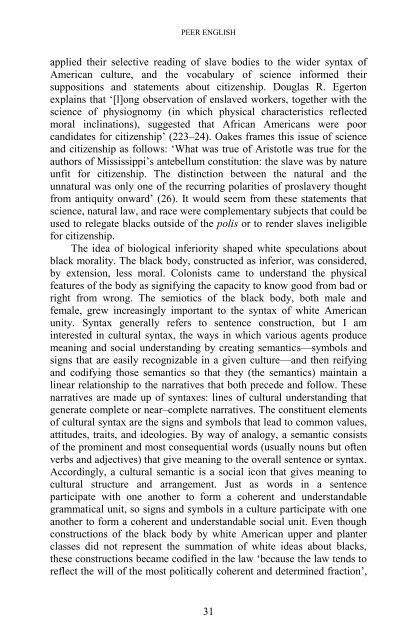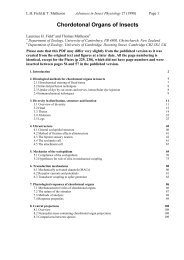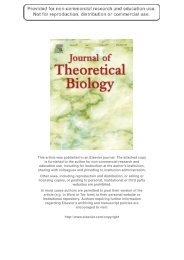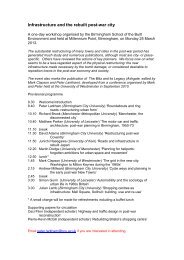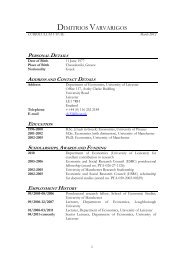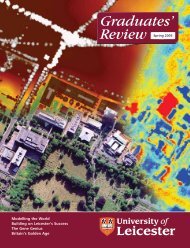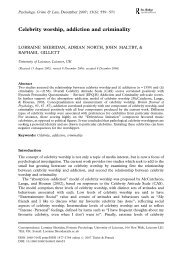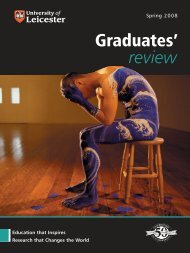From Natural Law to Natural Inferiority
From Natural Law to Natural Inferiority
From Natural Law to Natural Inferiority
Create successful ePaper yourself
Turn your PDF publications into a flip-book with our unique Google optimized e-Paper software.
PEER ENGLISHapplied their selective reading of slave bodies <strong>to</strong> the wider syntax ofAmerican culture, and the vocabulary of science informed theirsuppositions and statements about citizenship. Douglas R. Eger<strong>to</strong>nexplains that ‘[l]ong observation of enslaved workers, <strong>to</strong>gether with thescience of physiognomy (in which physical characteristics reflectedmoral inclinations), suggested that African Americans were poorcandidates for citizenship’ (223–24). Oakes frames this issue of scienceand citizenship as follows: ‘What was true of Aris<strong>to</strong>tle was true for theauthors of Mississippi’s antebellum constitution: the slave was by natureunfit for citizenship. The distinction between the natural and theunnatural was only one of the recurring polarities of proslavery thoughtfrom antiquity onward’ (26). It would seem from these statements thatscience, natural law, and race were complementary subjects that could beused <strong>to</strong> relegate blacks outside of the polis or <strong>to</strong> render slaves ineligiblefor citizenship.The idea of biological inferiority shaped white speculations aboutblack morality. The black body, constructed as inferior, was considered,by extension, less moral. Colonists came <strong>to</strong> understand the physicalfeatures of the body as signifying the capacity <strong>to</strong> know good from bad orright from wrong. The semiotics of the black body, both male andfemale, grew increasingly important <strong>to</strong> the syntax of white Americanunity. Syntax generally refers <strong>to</strong> sentence construction, but I aminterested in cultural syntax, the ways in which various agents producemeaning and social understanding by creating semantics—symbols andsigns that are easily recognizable in a given culture—and then reifyingand codifying those semantics so that they (the semantics) maintain alinear relationship <strong>to</strong> the narratives that both precede and follow. Thesenarratives are made up of syntaxes: lines of cultural understanding thatgenerate complete or near–complete narratives. The constituent elementsof cultural syntax are the signs and symbols that lead <strong>to</strong> common values,attitudes, traits, and ideologies. By way of analogy, a semantic consistsof the prominent and most consequential words (usually nouns but oftenverbs and adjectives) that give meaning <strong>to</strong> the overall sentence or syntax.Accordingly, a cultural semantic is a social icon that gives meaning <strong>to</strong>cultural structure and arrangement. Just as words in a sentenceparticipate with one another <strong>to</strong> form a coherent and understandablegrammatical unit, so signs and symbols in a culture participate with oneanother <strong>to</strong> form a coherent and understandable social unit. Even thoughconstructions of the black body by white American upper and planterclasses did not represent the summation of white ideas about blacks,these constructions became codified in the law ‘because the law tends <strong>to</strong>reflect the will of the most politically coherent and determined fraction’,31


